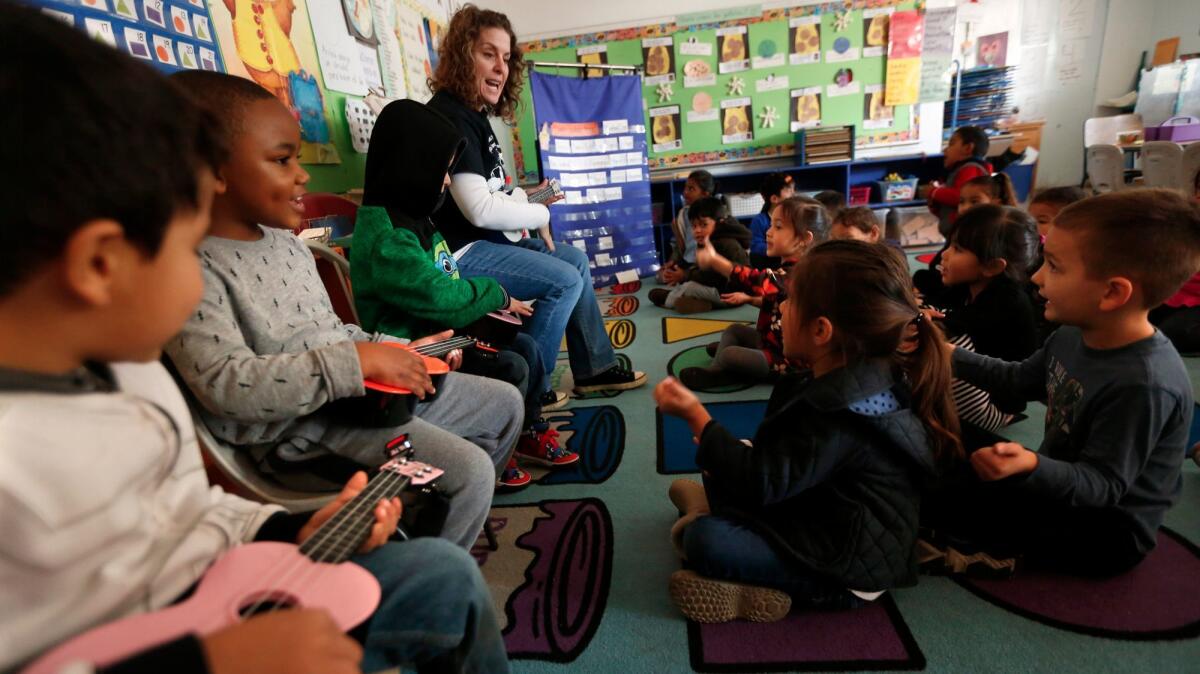L.A. Unified is expanding beneficial dual-language programs for preschoolers

- Share via
Most of the children in Hillary Erlich’s prekindergarten class speak to her in English.
“I’m done,” one boy in a white sweatshirt announced as he raised his hands from his sponge painting project on a recent morning.
But when she replied in Spanish, he followed her directions.
“OK, ve a lavar[te] las manos,” Erlich said. He ran to the sink to wash his hands.
The children in Erlich’s expanded transitional kindergarten class at Grand View Boulevard Elementary School in Mar Vista are almost all 4 years old. They are the youngest in the Los Angeles Unified School District to be enrolled in a dual-language program.
The district plans to open six or seven more dual-language programs for its youngest students in the fall, said Hilda Maldonado, executive director of L.A. Unified’s multilingual and multicultural education department. They’ll be taught half in Spanish, half in English.
The district currently has 87 K-12 dual-language programs, and about 16 more are in the works. The new preschool classes will open in schools that already have K-5 programs.
Research has shown that bilingualism has a wide range of benefits in children, helping their communication skills and giving them an edge over monolingual peers in their ability to focus and process information. These benefits can start as early as a baby’s first year, and children are likely to have a better mastery of a language the younger they start learning it.
“The younger children have an … ability to learn languages quicker and can retain a lot of that information,“ Maldonado said.
English learner students in dual-language programs also have more success becoming proficient in English by the end of high school, according to a study by Stanford University and the University of Oregon.
“We know how many of our children are already coming to us with another language,” Maldonado said. The aim, she said, is “to ensure that we’re not erasing that other language but really adding to it and using it as they’re also learning English.”
Joshua Castillo, an early education consultant who lives near USC, drives about an hour so her daughter can attend the Spanish dual-language class at Grand View. Castillo speaks English and Spanish fluently, but raises her daughters, who are 2 and 5, only in Spanish. She reads to them in Spanish. At home, they watch Spanish-language cartoons.
She left it to school to teach her daughter English, she said — and her plan worked.
“She pretty much learned English in a month and a half,” said Castillo, who declined to share her daughter’s name to maintain privacy.
Ideally, the dual-language class would be split 50-50, with half the kids having English as a first language and the other half having Spanish. In Erlich’s class, 60% started with English, so they tend to speak English to each other, she said. That can help the Spanish-speaking children with English development.
As for Erlich, she spends 90% of the school day speaking to her students in Spanish and integrates the language into every class activity.
After recess one day, the children sat cross-legged and sang their daily song, as three students learned how to play the ukulele. Erlich told them in Spanish how to hold the instrument, supplementing the vocabulary with hand gestures. Then she said in English, “One, two, ready, strum.”
“One, two, ready, sing,” she told the class.
“Buenos días, buenos días,” they sang. “Como estás, como estás?”
As the Grand View students grow up, the amount of English in their classes will increase every year. By fifth grade, they’ll learn in Spanish half the day and in English the other half.
Erlich often prompts the children to speak in Spanish, or accompanies her Spanish words with actions. When a student asked her for paint, she said, “Cuál?” When the boy pointed to the black paint, she prompted him: “Qué color es?”
The room is plastered with posters and assignments in two languages. Colorful letters on one wall’s orange poster board read, “Hablar Leer Cantar” and then, “Talk Read Sing.” On another board, students have cut construction paper into cookie shapes. Next to one little black and white circle are the words, “It’s an Oreo cookie” but also “Es una galleta de Oreo.”
Being bilingual will help her daughter be flexible and know that “there’s more than one way to solve a problem,” Castillo said. “If you can think about it in two different languages, ultimately that’s how I wanted her to think about everything, that I can get to a solution in more than one way.”
She also wants her child to be competitive as an adult. When Castillo grew up in South L.A., with Spanish as her first language, “being dual language was frowned upon,” she said.
But as an adult, she realized that her fluency in two languages gave her extra earning power and access to jobs.
“It’s a gift I can give my kid,” Castillo said.
How the kid uses it will be up to her.
To read the article in Spanish, click here
Reach Sonali Kohli at [email protected] or on Twitter @Sonali_Kohli.
More to Read
Sign up for Essential California
The most important California stories and recommendations in your inbox every morning.
You may occasionally receive promotional content from the Los Angeles Times.











